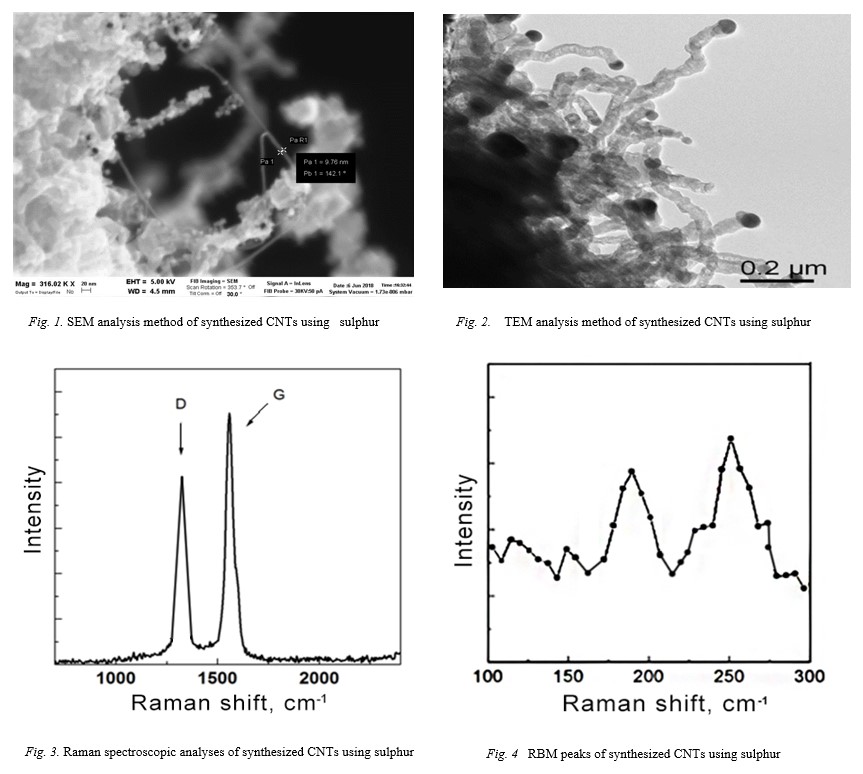ABSTRACT
However, sulphur has been made use of as a promoter for carbon nanotubes (CNTs) synthesis for many years, a clear understanding of the sulphur effect (essentially, for
efficient nanotube production) is still challenging. In this report, we intend to discuss the essential role of sulphur in an Aerosol–assisted chemical vapor deposition
(CVD) CNTs synthesis. Though sulphur is not incorporated into the CNTs structure, its presence, however, indirectly affects the yield, nanotube thickness, and even defines
a transition between single–, double–, and multi–walled CNTs. Scanning Electron Microscope (SEM), Transmission Electron Microscopy (TEM), and Raman Spectroscopy analyses
were carried out in order to investigate the complex role of sulphur in CNTs synthesis. The effect of sulphur addition as a promoter on the growth of CNTs and attempted to
provide insights into the role of sulphur during CNTs formation via catalyst characterization has been investigated
Keywords: Carbon nanotubes (CNTs), Sulphur, SEM, TEM, Raman Spectroscopy.
DOI:10.70784/azip.1.2024329
Received: 05.09.2024
Internet publishing: 24.09.2024
AUTHORS & AFFILIATIONS
Institute of Physics of the Ministry of Science and Education of the Republic of Azerbaijan
E-mail: rovshen_1989@mail.ru
Graphics and Images

Fig.1-2-3-4
|
REFERENCIES
[1] S. Iijima. Helical microtubules of graphitic carbon, J. Nature 354 (1991) 56–58.
[2] [2] N. Coustel, B. Coq, P.M. Ajayan, et al. Application of carbon nanotubes as supports in heterogeneous catalysis, J. Am. Chem. Soc. 116 (1994) 7935–7936.
[3] R. Andrews, M.C. Weisenberger. Carbon nanotube polymer composites, J. Curr. Opin. Solid State Mater. Science 8 (2004) 31–37.
[4] A. Bianco, K. Kostarelos, M. Prato. Applications of carbon nanotubes in drug delivery, J. Curr. Opin. Chem. Biol. 9 (2005) 674–679.
[5] Ihsan Ullah. Carbon nanotube membranes for water purification: developments, challenges, and prospects for the future, J. Sep. Purif. Technol. 209 (2019) 307–337.
[6] I.V. Zaporotskova, N.P. Boroznina, Y.N. Parkhomenko, L.V. Kozhitov. Carbon nanotubes: sensor properties. A review, Mod. Electron. Mater. 2 (2016) 95–105.
[7] Y. Zhou, Y. Zhu, B. Xu, X. Zhang. High electroactive material loading on a carbon nanotube/carbon nanofiber as an advanced free–standing electrode for asymmetric supercapacitors, J. Chem. Commun. 55 (2019) 4083–4086.
[8] L.F. Aval, M. Ghoranneviss, et al. High–performance supercapacitors based on the carbon nanotubes, graphene and graphite nanoparticles electrodes, J. Heliyon 4, (2018) e00862.
[9] A. Barreiro, C. Kramberger, et al. Control of the single–wall carbon nanotube mean diameter in sulphur promoted aerosol–assisted chemical vapor deposition, J. Carbon 45 (2007) 55–61.
|
